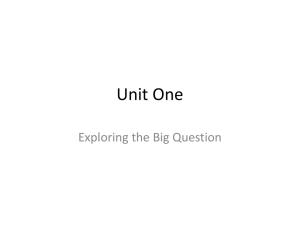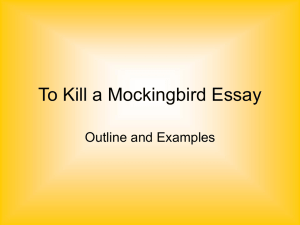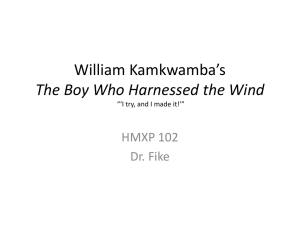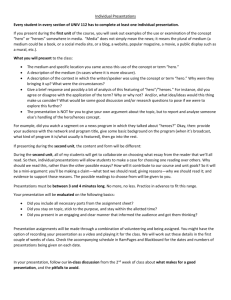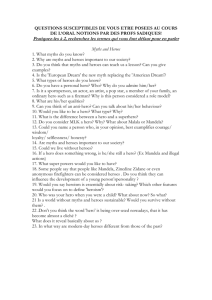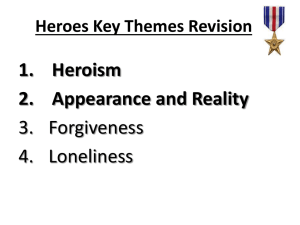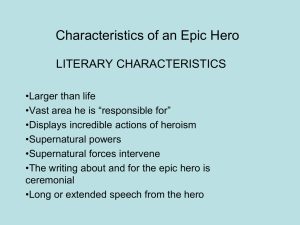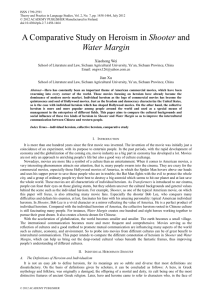World War I Lesson Plans
advertisement
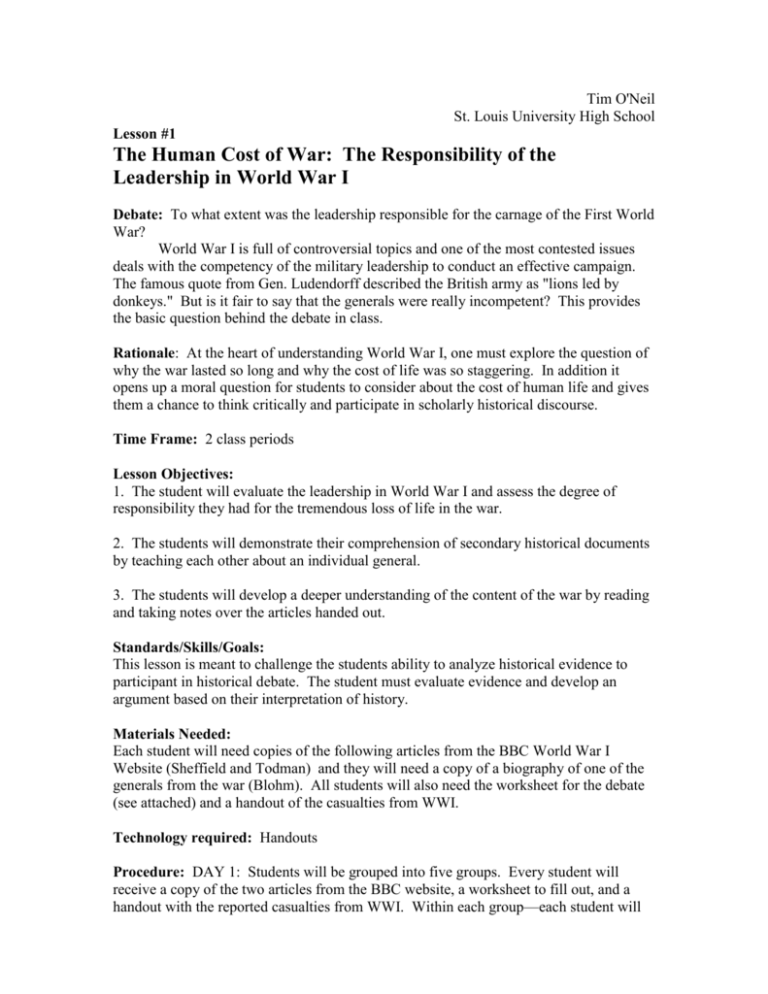
Tim O'Neil St. Louis University High School Lesson #1 The Human Cost of War: The Responsibility of the Leadership in World War I Debate: To what extent was the leadership responsible for the carnage of the First World War? World War I is full of controversial topics and one of the most contested issues deals with the competency of the military leadership to conduct an effective campaign. The famous quote from Gen. Ludendorff described the British army as "lions led by donkeys." But is it fair to say that the generals were really incompetent? This provides the basic question behind the debate in class. Rationale: At the heart of understanding World War I, one must explore the question of why the war lasted so long and why the cost of life was so staggering. In addition it opens up a moral question for students to consider about the cost of human life and gives them a chance to think critically and participate in scholarly historical discourse. Time Frame: 2 class periods Lesson Objectives: 1. The student will evaluate the leadership in World War I and assess the degree of responsibility they had for the tremendous loss of life in the war. 2. The students will demonstrate their comprehension of secondary historical documents by teaching each other about an individual general. 3. The students will develop a deeper understanding of the content of the war by reading and taking notes over the articles handed out. Standards/Skills/Goals: This lesson is meant to challenge the students ability to analyze historical evidence to participant in historical debate. The student must evaluate evidence and develop an argument based on their interpretation of history. Materials Needed: Each student will need copies of the following articles from the BBC World War I Website (Sheffield and Todman) and they will need a copy of a biography of one of the generals from the war (Blohm). All students will also need the worksheet for the debate (see attached) and a handout of the casualties from WWI. Technology required: Handouts Procedure: DAY 1: Students will be grouped into five groups. Every student will receive a copy of the two articles from the BBC website, a worksheet to fill out, and a handout with the reported casualties from WWI. Within each group—each student will get one of the following biographies (see Blohm)—Haig, Pershing, Ludendorff, Foch, and Petain. Students are to read their packet of materials regarding this controversy and also the biography of their general and fill out the appropriate sections of the worksheets. DAY 2: When students are prepared, they are to convene in their groups and teach their group members what they learned about their general and how he fits in the context of this argument. The group then discusses amongst themselves how much responsibility the generals deserve in this debate. After discussion takes place, the group then takes a vote as to where they feel is the correct historical interpretation regarding the generals. They create two written documents—the majority opinion and, if there were dissenting voices, they create the minority opinion. The two views and presented to the class by two representatives from the group and these will be handed in as their assessment of the assignment. Class discussion and debriefing will take place led by the teacher and based on the views expressed by the various groups. For assessment, the student will turn in his/her worksheet completed. In addition, the written opinions by the group will be graded. The worksheet is worth 10 points while the group opinion is worth 10 points. Scoring Guide: Clear statement of argument: 5----4----3----2----1 Comments: Use of accurate historical evidence as support: 5----4----3----2----1 Comments: TOTAL: ________/10 Sources: 1. Blohm, Craig. World War I: Leaders and Generals. Lucent Books, 2002. 11-84. 2. Sheffield, Gary. "The Western Front: Lions Led by Donkeys?" www.bbc.co.uk/history/worldwars/wwone/lions_donkeys_print.html 3. Todman, Dan. "World War One: Misrepresentation of a Conflict." www.bbc.co.uk/history/worldwars/wwone/perceptions_print.html Additional Materials: Laffin, John. British Butchers and Bunglers of World War One. Bramley Books, 1988. NAME:_____________________________ DATE:______________________ Lions Led By Donkeys: Debate of WWI Leadership Preparation Sheet Directions: Read the packet of materials with the two articles (Sheffield and Todman) and the biography of your general in preparation for our debate tomorrow. You should be prepared to teach your group about your general (so know him well!) and to think about the question of how much blame for the casualties of war be placed on the generals of the various belligerents in the war. This sheet should be filled out completely by class tomorrow! Gary Sheffield, "The Western Front: Lions Led by Donkeys?" 1. What is the author's thesis? 2. What are three pieces of evidence that Sheffield uses to support his argument? Dan Todman, "World War One: Misrepresentation of a Conflict?" 3. What is the author's thesis? 4. What are three pieces of evidence that Todman uses to support his argument? 5. Who is your general? 6. Provide a short description of personality/character based on the article 7. What event in his life helped shape him as a leader? 8. What crucial event led to his command of the army? 9. Evaluation as a leader (circle one): Why do you give the general this grade? A B C D F 10. Does this leader support or refute the argument of weak generals in World War I? 11. Leadership in the War Generals in the war Strengths John J. Pershing (USA) Erich Ludendorff (GER) Philippe Petain (FR) Douglas Haig (UK) Ferdinand Foch (FR) Weaknesses 12. Other than the leadership, what are other explanations for why the war was so destructive? What else is responsible for the high casualty rates? 13. To what degree should minimizing destruction (loss of life, property) be considered by the leadership when planning a conflict? Can such a thing be accurately predicted? 14. How much blame should be placed on the leadership in World War I. Were the soldiers truly lions led by donkeys? (choose one) a. THE GENERALS WERE DONKEYS!!! b. THE GENERALS DID THEIR BEST, GIVEN THE CIRCUMSTANCES. What do you rely on as the strongest piece of evidence? GROUP #:__________ NAMES:_________________________________ _________________________________ _________________________________ _________________________________ _________________________________ In your group your group must come to a consensus as to which side you agree with. Write a detailed paragraph (8-10 sentences) outlining your reasons for the decision of the group. However, if there is dissent within the group, then the dissenters need to make a minority opinion, outlining their reasons why they could not agree with the majority. DECISION OF THE GROUP (MAJORITY OPINION) MINORITY OPINION Lesson #2 Document Analysis and Debate: Heroism Rationale: Just as literature, cultures derive their heroes from the narratives of the past. Every society has developed a pantheon of heroes that it looks to for inspiration and guidance. Often, heroes are highly regarded as some form of perfection, elevated above the average human, although an analysis of their life story will quickly reveal the person to be flawed and mortal. Still the concept of heroism serves an important function in the culture and it is worth an exercise to define the culture's understanding of heroism by analyzing historical documents. World War I provides and rich and diverse playground for this discussion, since one can find examples of heroic deeds on the battlefield, but also in areas of protest, women's rights, and the homefront. Time Frame: 1.5—2 periods Objectives: 1. To explore the cultural understanding of heroism. 2. To analyze primary documents and incorporate them into evidence in an historical debate. 3. To assess the limits of heroism and history's ability to define heroes. Standards/Skills/Goals: This lesson requires the student to critically evaluate information from a variety of primary sources and interpret the historical information in debate. Moreover, the student will evaluate the cultural construct of a hero and consider the limits and/or validity of such a concept. Materials Needed: Copies of the primary and secondary sources cited below for each student and the handout provided. Technology Required: None Procedure: Handout worksheets. Pair up the class. Begin the class by having the students write down whom they regard as a hero and why they assign them this title and the students share their response with their partner. Then discuss the definition of what it means to be a hero. Solicit examples of heroes from the class. Then ask the students to discuss what the limitations of heroism are with their partner. What are qualities that are not heroic? After a few moments, ask for responses from the class. Then pass out the documents on WWI and have the pairs read and decide if the document is an example of heroism and why that is the case. Many other documents could be used for this exercise, so feel free to change them out for ones that you find to be more useful. Discuss the results after the students had the opportunity to read and consider the documents. Then ask the students why is it important that we have heroes. Finally, student pairs are assigned to find a primary document from WWI where they think heroism is demonstrated and a contemporary example of a hero. The students must justify in both cases why they chose these examples of heroism. Scoring Guide: Student completes worksheet on primary documents: ______/5 Student participates in class discussion and with partner: ______/5 Student and partner submit an historical example of a hero and a contemporary example of a hero. ______/10 TOTAL: ______/20 Sources: "Awards of the Congressional Medal of Honor." American Decorations: A List of Awards of the Congressional Medal of Honor, the Distinguished-Service Cross, the Distinguished Service Medal, the Soldier's Medal, and the Distinguished Flying Cross, Awarded under Authority of the Congress of the United States, January 1, 1927—June 30, 1937. US Government Printing Office, Washington: 1937. "Senator Norris Opposes U.S. entry into the War." Congressional Record, 65th Cong., 1st Sess., Vol. LV, pt. I, pp. 212-213. http://net.lib.byu.edu/~rdh7/wwi/1917/norris.html Taylor-Whiffen, Peter. "Shot at Dawn: Cowards, Traitors or Victims?" www.bbc.co.uk/history/british/britain_wwone/shot_at_dawn_print.html "The U.S. Sedition Act." United States, Statues at Large, Washington D.C., 1918, Vol. XL, pp. 553 ff. http://net.lib.byu.edu/~rdh7/wwi/1918/usspy.html Extract from List of Missouri Army soldiers killed in action, 1918. Photograph of Suffragette protesting in front of white house. NAME:___________________________ NAME:___________________________ Exploring Heroism in World War I Name one person you believe to be a hero. What reasons/qualities does this person possess that qualify him/her to be a hero? What is a definition of heroism? What specific qualities are NOT heroic? DOCUMENT 1 Does this qualify as heroism? Why or why not? DOCUMENT 2 Does this qualify as heroism? Why or why not? DOCUMENT 3 Does this qualify as heroism? Why or why not? DOCUMENT 4 Does this qualify as heroism? Why or why not? DOCUMENT 5 Does this qualify as heroism? Why or why not? DOCUMENT 6 Does this qualify as heroism? Why or why not? Who is your Hero from World War I? Explain. ________________________________________________________________________ ________________________________________________________________________ ________________________________________________________________________ ________________________________________________________________________ ________________________________________________________________________ ________________________________________________________________________ ________________________________________________________________________ ________________________________________________________________________ ________________________________________________________________________ ________________________________________________________________________ ________________________________________________________________________ ________________________________________________________________________ Who is your Hero from Today? Explain. ________________________________________________________________________ ________________________________________________________________________ ________________________________________________________________________ ________________________________________________________________________ ________________________________________________________________________ ________________________________________________________________________ ________________________________________________________________________ ________________________________________________________________________ ________________________________________________________________________ ________________________________________________________________________ ________________________________________________________________________ ________________________________________________________________________ ________________________________________________________________________
